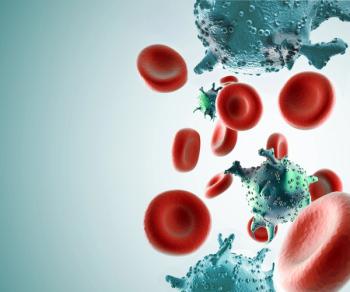
Number of Extranodal Sites in DLBCL Did Not Affect Survival With Abbreviated, Full Course Rituximab
The number of extranodal sites of disease did not influence outcomes among young patients with high-risk DLBCL treated with rituximab-dose-dense chemotherapy with or without high-dose chemotherapy and autologous stem-cell transplantation.
The number of extranodal sites of disease did not influence outcomes among young patients with high-risk diffuse large B-cell lymphoma (DLBCL) treated with rituximab-dose-dense chemotherapy with or without high-dose chemotherapy and autologous stem-cell transplantation.
A study
Annalisa Chiappella, MD, of the department of hematology at Azienda Ospedaliero Universitaria Città della Salute e della Scienza in Turin, Italy, and colleagues concluded that based on these results, early consolidation could not be recommended and that the full course of rituximab-dose-dense chemotherapy should remain standard of care for patients with DLBCL with poor prognosis.
After the study was published, Tetsuya Tanimoto, MD, of Jyoban Hospital of Tokiwa Foundation, Japan, and colleagues submitted a
Eligible patients had intermediate-high risk or high-risk scores of 2 to 3 in the age-adjusted International Prognostic Index (aa-IPI) based on ECOG performance status, concentration of serum lactate dehydrogenase, and Ann Arbor staging. However, Tanimoto and colleagues pointed out that the aa-IPI was developed prior to the rituximab era.
“Some researchers suggest that the presence of more than one extranodal site of disease, as compared with no extranodal sites or one extranodal site, was associated with significantly inferior overall and progression-free survival even in patients younger than 60 years, and the standard IPI might be more suitable than the aa-IPI for selecting high-risk younger patients with DLBCL in the rituximab era,” they wrote.
In the Chiappella et al study, about one-third of patients (32%) had more than one extranodal involvement in each group. Because of that, Tanimoto and colleagues inquired whether there were any differences in treatment response and survival results in patients with or without these features.
By the end of treatment, 76% of patients with no or one extranodal site of disease achieved complete response compared with 69% of patients with more than one extranodal localization. During the first year of follow-up, patients with more than one extranodal site of disease had reduced failure-free and overall survival compared with patients with no or one extranodal site, but these differences disappeared over time.
Failure-free survival was 66% at 2 years for both groups. Overall survival at 5 years was 76% for those with more than one extranodal site compared with 78% for those with no or one extranodal site.
Newsletter
Stay up to date on recent advances in the multidisciplinary approach to cancer.


















































































